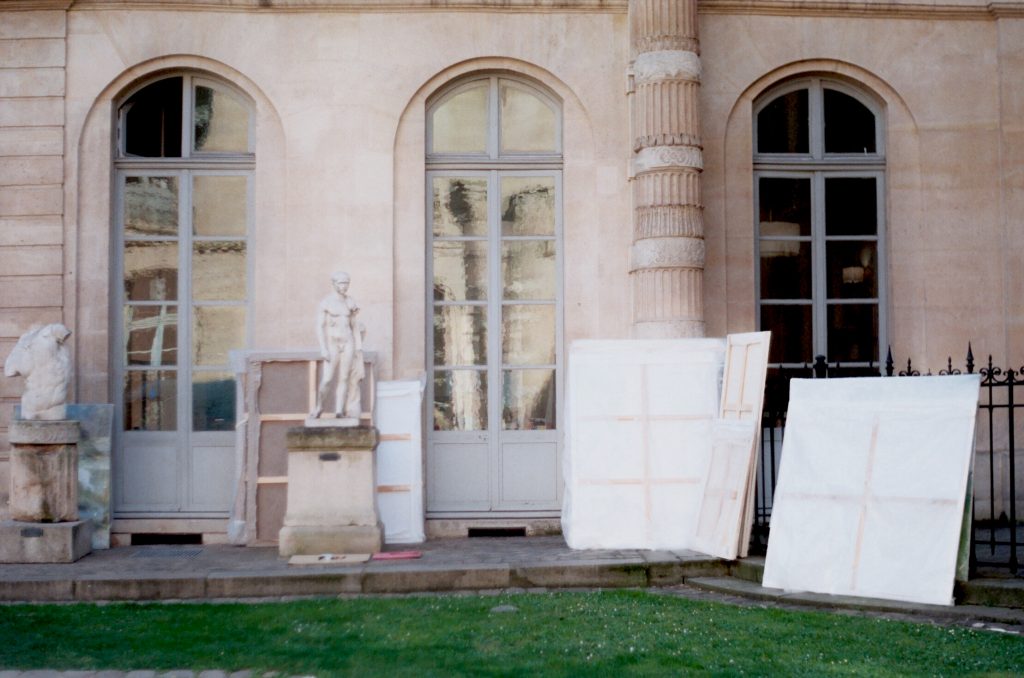
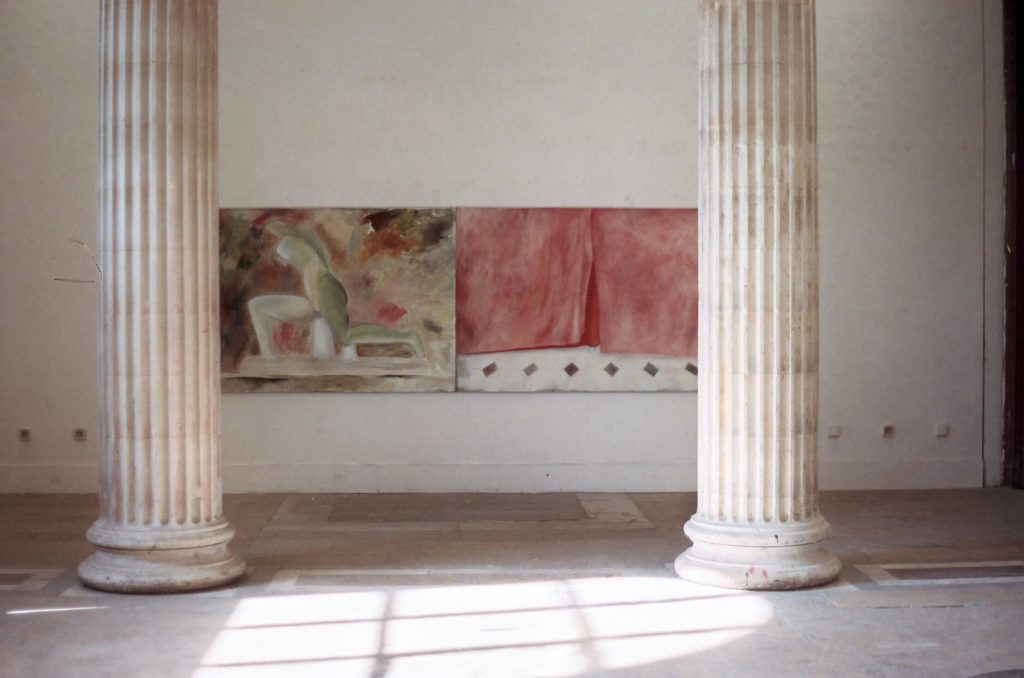
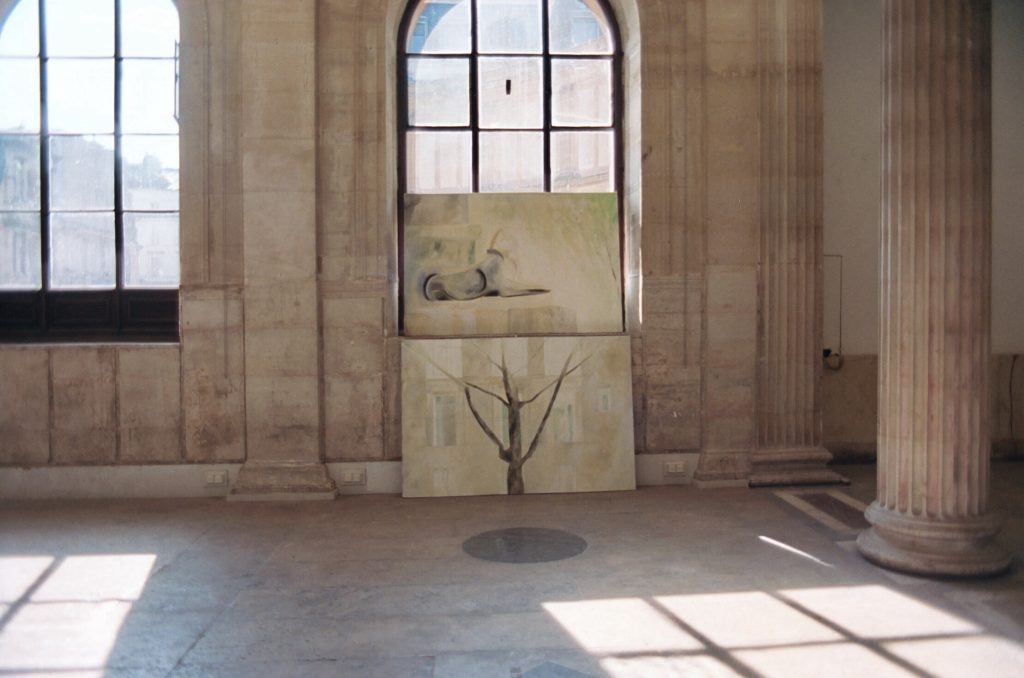

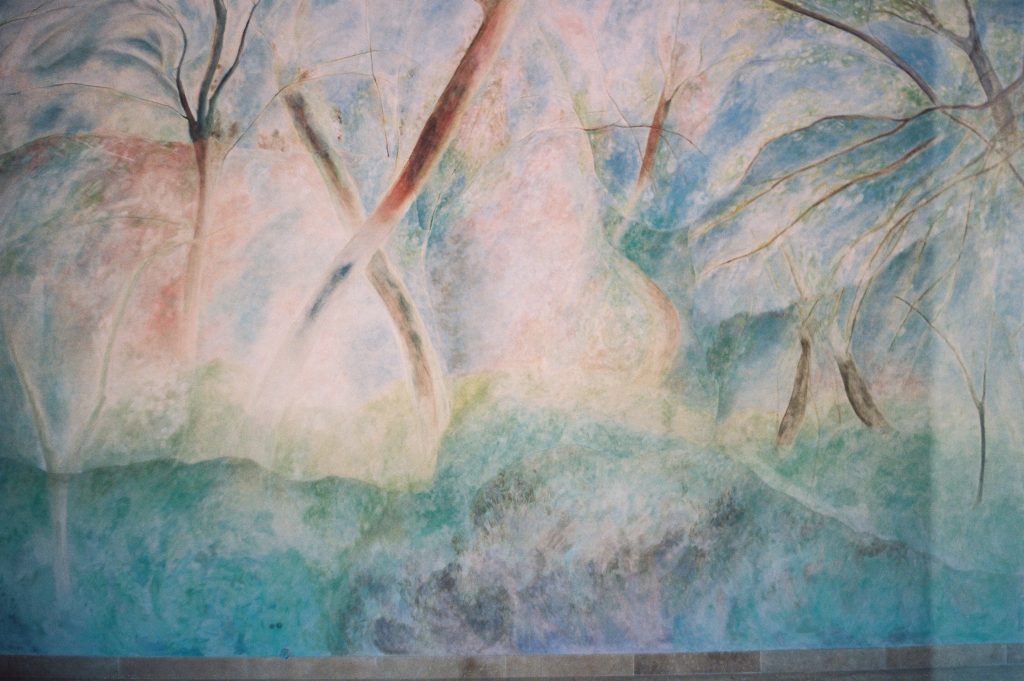
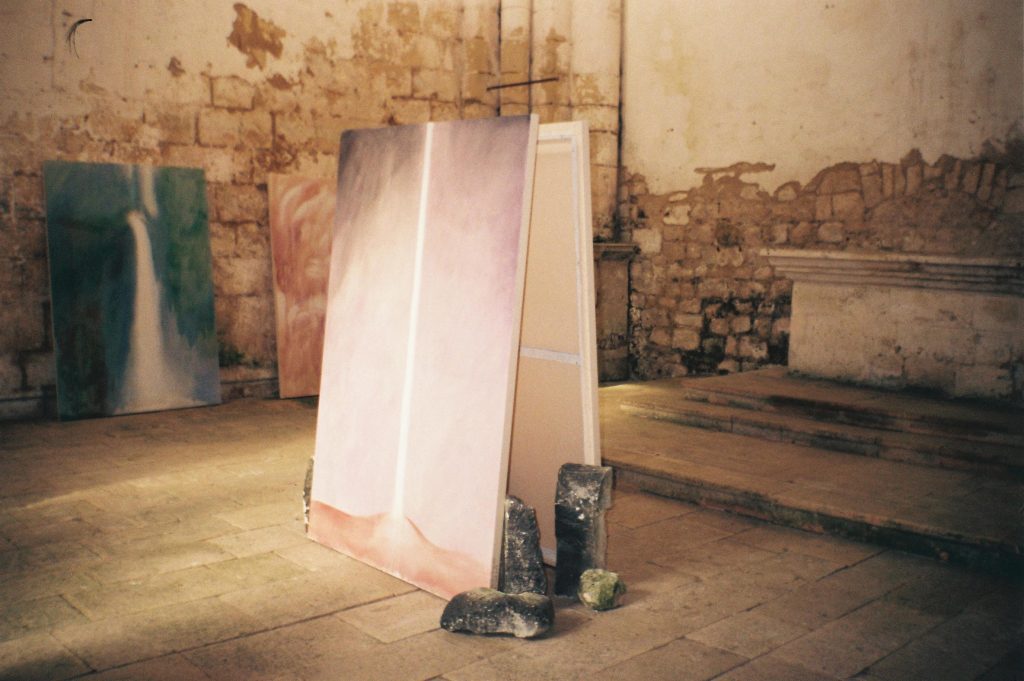
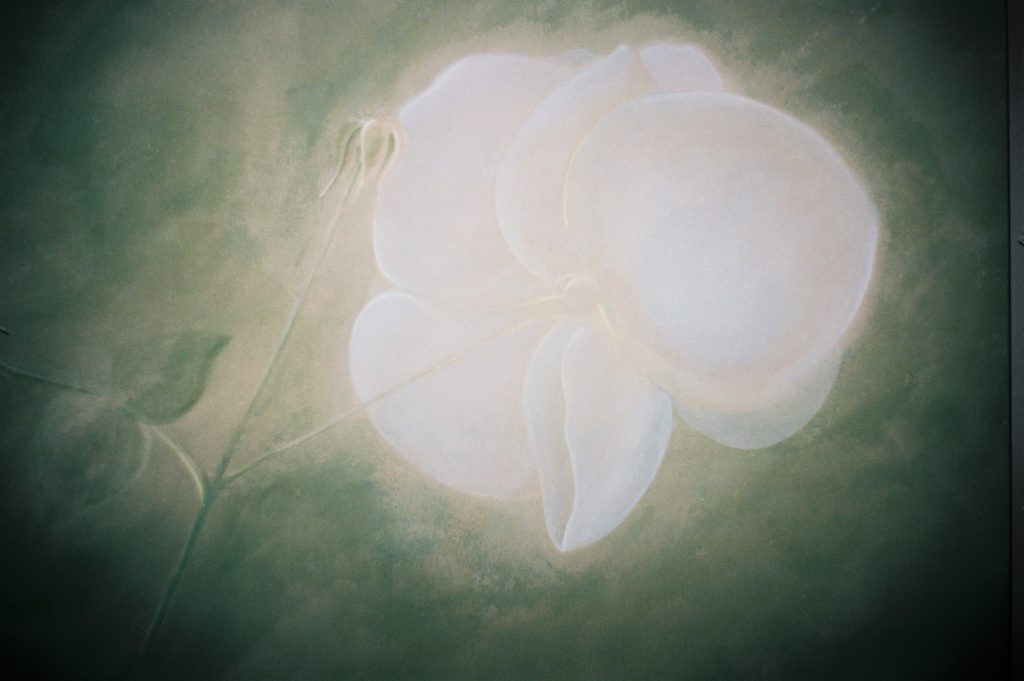
photos © Nino Kapanadze, 2023
Nino Kapanadze (ნინო კაპანაძე) is an artist born on 5th of June 1990 in Tbilisi, Georgia. Lives and works in Paris, France. Represented by Almeida & Dale, São Paulo, Brazil.
Education
2020 – 2023 Diplôme National Supérieur d’Arts Plastiques (MFA), Beaux-Arts de Paris, Paris, France
2018 – 2020 Master’s degree, Paris Institute of Political Studies (Sciences Po), Paris, France
2012 – 2015 Master of Architecture, Tbilisi State Academy of Fine Arts, Tbilisi, Georgia
2011 BAUHAUS Dessau Foundation, Dessau, Germany
2010 University of Helsinki, Aalto University of Technology, Helsinki, Finland
2007 – 2011 Tbilisi State Academy of Fine Arts, Tbilisi, Georgia
Solo exhibitions
2025 June 5 – July 5, Cavalcades, Villa Atrata Palais-Royal, Paris, France
2025 May 24 – June 22, Cascades, Chapelle Saint Croix, Villa Atrata, Angles-sur-l’Anglin, France
2025 March 7 – May 24, Rendezvous, curated by Marta Papini, Fondazione Bonollo Arte Contemporanea, Thiene, Italy
2024 March 21 – April 27, The cruellest month, Crèvecœur, Paris, France
2023 July 14 – September 3, დოღი, LC Queisser, Tbilisi, Georgia
2023 June 21 – 23, NOT ONLY / BUT ALSO, Beaux-Arts de Paris, Paris, France
2022 March 17 – April 9, presentation of დოღი HORSE RACE II and reading an essay How To Draw A Horse, in the frames of project L’Avancée, Fondation Pernod Ricard, Paris, France
2021 June 21, Diplôme national d’arts plastiques, Beaux-Arts de Paris, Paris, France
2019 June 5 – 15, Keeping Things Whole, Berkeley Books of Paris, France
Monumental fresco
Title: X
Artist and painter: Nino Kapanadze
Material: Affresco (Buon Fresco)
Size: 555 cm x 367 cm
Year: 2024
Place: Le Moulin des Ribes, Grasse, France
Technical assistance: Marius Allier
Initial formation and guidance: Philippe Bennequin
Silvia Fiorucci collection, Monaco
Documentary video: Affresco, a very long day
Book: Affresco X Nino Kapanadze edited by Nathan Rousseau, Paris, 2025
Group exhibitions
Selected group exhibitions include: Maison CLEARING, curated by Olamiju Fajemisin, Basel, Switzerland; Studio Conversations, curated by Anaël Pigeat, David Zwirner, Paris, France; TRIP DOWN MEMORY LANE, at la Gaya Scienza, Nice, France; Looking for Free Knots, curated by Maria Katia Tufano, Le Quai contemporary art space, Monte Carlo, Monaco; Prélude, at Super Dakota, Brussels, Belgium; Cache Cache, curated by Cecile Attal, PERROTIN Paris, France; EXTASE DE L‘ABÎME, curated by Cristiano Raimondi, Società delle Api, Le Quai contemporary art space, Monte Carlo, Monaco; M O V I N G at Andréhn-Schiptjenko, Paris, France; CRUSH (2nd edition) curated by Alexia Fabre, Audrey Illouz and Cristiano Raimondi, at Beaux-Arts de Paris, Paris, France; Jardin Secret, curated by Noam Alon, Le Théâtre des Expositions, Paris, France.
Texts
by Eva Fabbris, Museo MADRE, March, 2025
« In Nino Kapanadze’s work, pictorial transparency is equivalent to a form of expressive tenderness. An oneiric reality, in which environments, patterns, figures and narratives draw on a cultured universal vocabulary, shows in her surfaces an underlying and delicate vibration of energy… almost static but no less powerful for that. We need to listen to it! »
by Marta Papini, Rendezvous, Fondazione Bonollo, March 2025
Rendezvous marks the first solo exhibition in Italy of Parisbased Georgian artist Nino Kapanadze. From its very title, Rendezvous celebrates the dimensions of encounter, dialogue, tenderness, and love – an inspiration kindled by a visit to Padua’s Scrovegni Chapel. The chapel’s southern and northern walls house The Stories of Joachim and Anna, Mary and Christ, and it is amid these various scenes that Giotto rendered what is considered the first kiss in the history of art, the one shared by Anna and Joachim.
In homage to that gesture of affection, within the space of the Chiesa delle Dimesse, Kapanadze has installed two large, soft, and semi-transparent chiffon drapes, hand-coloured with pigments that evoke the hues of the cloaks worn by the figures in Giotto’s painting Joachim and Anne Meeting at the Golden Gate (circa 1303–1305). Each drape, measuring over twelve metres in length, emerges from wooden windows adorning the upper portions of the church’s side walls and cascades lightly until they converge on the floor in front of the altar. The drape on the left is rendered in Mars Red, recalling the colour of Saint Joachim’s cloak, while the one on the right is painted in Golden Ochre, echoing Saint Anna’s mantle, similarly to how the Chiesa delle Dimesse originally featured paintings of these very saints flanking the altar. In lieu of an altarpiece, a large roundel in deep blue tones celebrates Giotto’s legendary ability to freehand a perfect circle. In the adjacent spaces, twenty-six monochrome works on paper serve as a visual catalogue for the exhibition, as if the artist wished to unveil her palette before inviting us into a world of delicate hues and suspended atmospheres. These twenty-six cotton sheets capture what is otherwise impossible to seize: fragments of sky, clusters of clouds, subtle nuances of mist, and ethereal substances that have gently settled on the rough texture of the paper.
In the third room, centred on the wall, Rendezvous 31 is exhibited. Set against a starry backdrop, two semi-spherical elements meet, their union sparking flashes of cold fire, the colour of ice, in a seemingly gravity-defying display. One cannot help but recall the word rendezvous as used in astronautical language, a term used to describe the manoeuvre of two objects approaching one another in space. In contrast to such a celestial scenario, Rendezvous 28 and Rendezvous 27, positioned to the left and right respectively, depict the slender branches of a tree silhouetted against a blue sky and a bird so light that it appears to merge with the desert landscape below. In the room at the rear of the church, typically used to display the collection, two additional canvases, Rendezvous 29 and Rendezvous 30, engage in a distant dialogue. The sensuously unfurled bloom of an orchid emerges from a milky white background, conversing with a will-o’-the-wisp that seems to materialise on the water’s surface. Kapanadze plays with the elements, rendering them permeable and ephemeral. She fuses air with earth, fire with water, inviting us into an ancient realm where all was one.
by Guitemie Maldonado, The cruellest month of Nino Kapanadze, Crèvecœur, March 2024
Raising colours, arising emotions
A particular tonality emerges from Nino Kapanadze’s most recent paintings, a light, an atmosphere, all the
more perceptible from one picture to the next as the formats are identical – comfortable for the body that
paints, welcoming to the viewer, taken vertically or horizontally. The paintings are either isolated or adjoined. Discreetly, beyond and beneath the subjects being depicted, there is a propulsion towards a purely pictorial and sensorial quest, focussed on the painted space and the emotions that may arise there. Everything here – trees, human figures, books, even walls or other architectural elements – becomes manifest as a more or less fleeting presence, an emanation, an apparition on the verge of visibility, which is in turn indicated not as something clear, but instead an open question, constantly being raised. The treatment of colour plays a great role, with both a transparency and a fluidity, as well as the materials and the pictorial surface. While the technique is classical, oil paint on linen canvas, the use the artist makes of it produces here and there effects close to non-painting, or at least an effacement. The manner that it has been formed as in a fresco – the way of taking colours in the depth of a pictorial layering – resonates in the paradoxical density that it gives her spaces, in a continuity between them and all the various forms they contain: such are the driving forces of this delicate and yet radiant sensuality which can be felt on contemplation. Just as the mist lifts in the morning through condensation and evaporation, as the sap rises in springtime in the trunks of trees towards their growing leaves, life, in its intense mellowness, innervates these paintings, in which the slightest green filament, the least red space, the slightest splash and the
smallest blossoming become the most precious manifestations. By quoting the first line of T. S. Eliot’s The Waste Land, “April is the cruellest month”, Nino Kapanadze gives her works a season; to be precise, she places them between the winter that witnessed their birth and the springtime that begins at the moment when they are displayed. When winter turns towards spring, such a crossing-over suggests colours, from whites to greens, of a life flowing back in a tenuous return. Like that “awakened day, which still wore the moon as a necklace like a silver gem” as evoked by Robert Walser, or the “stuttered-over-again world” that Paul Celan attempted to convey, there can here be felt the fluttering of beginnings. And, quite naturally, we are led towards poetry and the way in which meaning arises from it, which, like a cloud, in the words of Pierre Alferi “offers itself and recedes, unfolds, holds back”: “While disengaging itself, it adopts a certain figure, like a smoke ring. Fully heard and felt, each phrase leaves behind the memory of a volume with fleeting borders, which more or less melds with previous ones. And, when looking up from the book, we can see these memories with their shifting, mobile forms, as they cohabitate, become joined or disjointed.” In Interruption we see a figure, obscured by veils, hands open over a closed book with clouds of bright colours seemingly emanating from it, as with the genie of the lamp, mottling the greater part of the surface. So, with veils, various frames (windows, tiling, encasings, crannies), whose function is not to circumscribe or block what cannot be contained, but instead to reveal, even fleetingly, what has just been inscribed within them, like those tiny white dots that form the pearls of a necklace (those are pearls that were his eyes) or fine white lines highlighting the contours of a hand and thus of a gesture, or which sketch out the curve of a shoulder and the roundness of a head. “White has a tendency to make things visible” , stated Robert Ryman, who wanted to paint paint, not white per se. In the same way, the use Nino Kapanadze makes of colours, which might be described as powdered, takes part in these arrangements that aim at capturing what is visible: because a ray of light is never seen more clearly than when it has been filtered and brought out by the various particles or projected images suspended in it. For, it is also light that, in a certain respect, reveals everything that is being diffused imperceptibly in the apparent transparency of the air. By trapping one another, light and dust reveal each other. Another passage from The Waste Land then comes to mind: “(Come in under the shadow of this red rock), / And I will show you something different from either / Your shadow at morning striding behind you / Or your shadow at evening rising to meet you; / I will show you fear in a handful of dust”. This is why self-portraits are made from behind, why figures have closed eyes or half-effaced traits that have barely been sketched out: they have been absorbed within themselves and in the paint, making them resonate even more. If they close their eyes to the light (all the lights you closed your eyes to), it is to make it radiate more, to be run through, since “being is being / pierced / daylit”, by the light that emerges from inside the paintings, from their very materials, as in the icons that Nino Kapanadze has so often observed in the churches of her native Georgia. And this is from where, via sensations, emotions emanate, like air being breathed out and forming a mist on the surface of a mirror, disturbing reflections and signifying life.
by Gvantsa Jgushia, დოღი, LC Queisser, July 2023
LC Queisser is pleased to present ,,დოღი” [Doghi], Nino Kapanadze’s first solo exhibition with the gallery The exhibition features a selection of recent paintings by Paris-based Georgian artist, including two diptychs completed under the Horserace series that emerged in 2021, reverberating in the titling of the show. In her signally observant painterly practice, Kapanadze cautiously draws upon visual and literary references ranging from ancient, classical, and modern art historical traditions to contemporary principles of image-making.
“…any time we decide to speak up and even more so to write down something, we risk sounding dumb,” writes the artist in her essay How To Draw A Horse, read in 2022 at the Foundation Pernod Ricard, Paris, in correspondence to Mark Strand’s interview statement with Karl Elder. For equivocal reasonings, one resorts to spelling out the concern-relevant subject matter in an almost primitive or Martha Roslerian monotonous temper when faced with phrenic exhaustion. Kapanadze’s monologue-style explanatory essay on how to draw a horse, or more so why to draw a horse, similarly finished with a chronological recital of all the equine phantoms – Assyrian horses, Lion Hunt of Ashurbanipal reliefs from Nineveh, Greek horses, Roman horses, Medieval horses, Early Renaissance horses, Uccello’s The Battle of San Romano, Late Renaissance horses, All the horses of George Stubbs, Eugène Delacroix’s Horse Frightened by Lightning, Edgar Degas’ Before the Race, and At the Races, Raoul Dufy’s Le Cavalier arabe, Erich Heckel’s Reiter, Apollon Kutateladze’s Battle of Queen Tamar, Susan Rothenberg’s horses – like an exorcism ahead of approaching the oldest artistic motif of human history.
Referred large-scale abstract paintings of Nino Kapanadze spell out Doghi in the latest Georgian script Mkhedruli [cavalry]. Initially utilized for secular writing as opposed to the two prior writing systems Asomtavruli and Nuskhuri, it derives from mkhedari, a native word for a horseman, and allows one to write in cursive or flowing looped manner.
Kapanadze’s final rendering of the violent elegance of the animals witnessed in ceremonial horseraces, held annually in Iarajulebi (a village in the Caucasus mountains) in honor of the deceased with one riderless horse (consecrated to the late’s spirit), becomes mere lettering of დოღი. Barely suggesting the morphology and gait of a horse by hurried, rough lines, the symbolism embedded in this perpetual motion creates a universal vocabulary of patterned movement. As a result of her formal experimentation with Equestrian painting, the artist’s thought trajectories in visual articulation, the long mental bouts, become traceable in a rather evidential physical form of handwriting. The oval dynamism here transcends the futurist lust to tame the fleeting moment, the forceful full gallop. Instead, Kapanadze captures the moving subjects through foregrounding vertical brushstrokes or its ephemeral traces concluding in downsloping curves, looking down at the earth, while a representation of any environment employs a straightforward, binary tactic, splitting the sky and land with a soft luminous crust right in the middle. Abstracted serene backgrounds emerge desolate landscapes, which succeed in constructing an ethereal space beyond the confined frame through reduction and erasure. Like the sole free-roaming “spirit horse” (consecrated to the deceased) at Doghi, still harnessed with a saddle, the artist grasps figures via their absence and materiality of the space via particular humidity that fills her canvas.
by Marjorie Bertin, Beaux-Arts de Paris, June 2023 FR
by Noam Alon, NOT ONLY / BUT ALSO, Beaux-Arts de Paris, June 2023
The most apparent common feature in Nino Kapanadze’s oeuvre is its format. Coherence is found then in
the scale of 195 x 130, though not clearly in the subject matter. The depicted universes vary with a lot of
freedom, being disloyal to either visual guidelines or a fixed perspective. However, while seeking a common thread, one can feel Kapanadze’s paintings are full of secrets that their preciousness will be spoiled once translated into words. We need thus to perceive the richness of their layers while standing on a threshold, embracing the hindrance created by the desire to know more. The struggle to accumulate these paintings into concrete conclusions leaves us in doubt, like Saint Thomas in his search for the real. Though here, it is Kapanadze who penetrates our flesh with her surfaces of colors, resembling in some cases human inner and outer tissues.
The human presence is almost absent here, fading with its surroundings, becoming transparent and dazzling like running water on a sunny day. Who are these ghosts then? Do they necessarily come from the past or are they perhaps locked in an eternal present? We are somehow always haunted, as Derrida said in relation to the Specters of Marx. The latter seems to be relevant to Kapanadze, who was born in Georgia a few months before it gained its independence from the Bolshevik regime. As a child, Nino grew up while observing two parallel aesthetic movements: the revival of Georgian Orthodox iconography and the decay of Soviet Modernism. “A GHOST,” Marcel Duchamp once stated, “is a portmanteau of a Guest and a Host.” It seems as if, by this assertion, he wanted to remind us of the everlasting tension between the artist and the observer – who tries persistently to decipher the rules of the artist’s realm. Confronted with Nino Kapanadze’s body of work, the observer should not look in the obvious directions. A tree shall not be evaluated by its height but more likely by the energy it invests underneath the ground.
Tenderness is required here, as well as heightened senses.
by Clara Delettre, Lafayette Anticipations, 2023 EN FR
by Nino Kapanadze, essay On Painting, 2022
« I am interested in painting practice not only as a medium of image creation, a surface, but also a space where I can develop a conversation, activate conflict zones and be in constant revelation of what a painting could be. Avoiding the idea that an image has a fixed end or a fixed viewing point, neither category nor predefined identity, I explore the light, sensation of movement, varying tempo and transparency within the realm of canvas. Embracing contradictions whilst controlling dissonances. I want my painting to dominate subject matter but intensity of content and juxtaposition of meanings and/or open-ended questions are integral parts of my practice. Thinking and creating paintings singularly, also in pairs, triples and in larger systems, I examine resistance of the image against relativity and engage in simultaneous languages. Technically vaste medium usage that covers traditional oil painting, as well as pigments based Byzantine Tempera and Italian Affresco practice, allows me to exploit colour and line in untranslatable order. Experience of painting carries more truthfulness than empirical truth itself, such experience leading towards beauty, recognition of which is primal, instant and sensorial. »
Editions
X Nino Kapanadze, edited and printed by Nathan Rousseau, Paris 2024
Institutional collections
Fondazione Bonollo Arte Contemporanea (IT)
Sigg Art Foundation (FR)
The Noewe Foundation (LT)
Fonds de dotation Famille Moulin / Fondation Lafayette Anticipations (FR)
Contact
studio@ninokapanadze.com